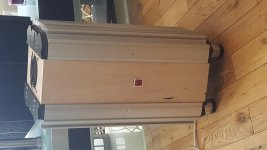i have built a JLH-96 amplifier.
i need to know how many amps to put through output transistor to get 10 watts. Power rails are +/- 15 volts.
So simple answer is 10/30=1/3 amp
is this correct as what passes through output transistor wont all go to speaker ?
or do i need more power to get 10 watts into the speaker ?
i need to know how many amps to put through output transistor to get 10 watts. Power rails are +/- 15 volts.
So simple answer is 10/30=1/3 amp
is this correct as what passes through output transistor wont all go to speaker ?
or do i need more power to get 10 watts into the speaker ?
Doesn't it depend on load resistance??
If you wanted 1,000 Watts, and only had 30V supply, you figure 33.33 Amps. But 30V at 33.33 Amps is 0.9 Ohms, which is not a common loudspeaker impedance.
Also, we conventionally rate in Sine RMS, which brings in 1.414 and other irrational numbers.
And in this amplifier the idle current is half the peak current (not the RMS or Average current).
If you wanted 1,000 Watts, and only had 30V supply, you figure 33.33 Amps. But 30V at 33.33 Amps is 0.9 Ohms, which is not a common loudspeaker impedance.
Also, we conventionally rate in Sine RMS, which brings in 1.414 and other irrational numbers.
And in this amplifier the idle current is half the peak current (not the RMS or Average current).
P = I x I x R
If your average power is 10W, then your peak power is 20W.
So your peak I = sqrt( 20/R )
About 1.6A for an 8 ohm load.
If your average power is 10W, then your peak power is 20W.
So your peak I = sqrt( 20/R )
About 1.6A for an 8 ohm load.
Power = I^2*R. So for 8ohm and 10W, I^2 = 10/8 therefore I = 1.1ARMS. This requires a peak current of 1.58A.
Is the JLH amp push-pull or SE?
Is the JLH amp push-pull or SE?
For a push pull class A amp, the idle current should be the supply voltage divided by twice the load impedance - plus a bit to make sure it doesn’t clip early or come out of class A when the load goes below nominal. So figure an amp for 8 ohms, two for 4 on a 15 volt rail. More would be better if you can stand the dissipation.
For single ended class A you have to double it.
For single ended class A you have to double it.
i am currently running it with a heat sink.
i am letting it get to 50 degrees C and current there is around 500mA.
to get more power needs a bigger heat sink.
i am letting it get to 50 degrees C and current there is around 500mA.
to get more power needs a bigger heat sink.
Some calculations above are somewhat optimistic, because they do not include real world transistor losses or only calculate dissipated power, not power into the load, or idle current is insufficient to maintain Class A at high power.
With 15V rails you can have, best case, 13V peak
Into 8 ohm:= 1.625A peak
Idle current= 1.625A/2= 0.8125A
Peak power= 13V*1.625A=21.125W
RMS power= 10.567W
So expected 10W RMS is *just* achievable.
Total dissipation will be 0.8125A*30V=24.375W
With 15V rails you can have, best case, 13V peak
Into 8 ohm:= 1.625A peak
Idle current= 1.625A/2= 0.8125A
Peak power= 13V*1.625A=21.125W
RMS power= 10.567W
So expected 10W RMS is *just* achievable.
Total dissipation will be 0.8125A*30V=24.375W
Last edited:
Push it to 70°C, and see what current you get. 0.5A bias, gives max 1A peak , 4W rms. 8 ohm load means min 6.2 ohms.
Position the heatsink to get the wings vertical.
Position the heatsink to get the wings vertical.
Last edited:
I've got some HUGE heatsinks here if you are interested.
I used two of them to build a lovely Pass Aleph J.
They are very heavy so would be better collected from B98.
The wood work isn't included, it just shows how I used them.
I used two of them to build a lovely Pass Aleph J.
They are very heavy so would be better collected from B98.
The wood work isn't included, it just shows how I used them.
Attachments
Last edited:
What are those, about 2 and a half feet long? Looks like they were made for some monster car amp.
I would read this lot: The Class-A Amplifier Site it has the original articles from JLH. You will see that the recommended quiescent current for the JLH-96 is 2A
Brian
Brian
- Home
- Amplifiers
- Solid State
- Class A amplifier watts

